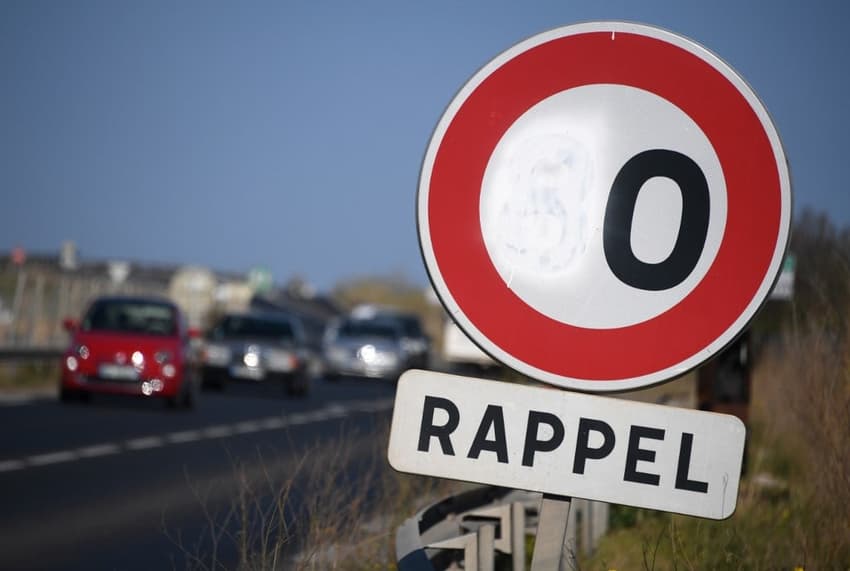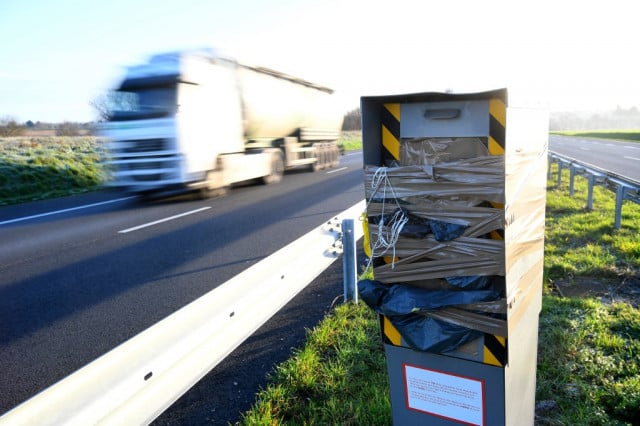'Hang on, is it 80 or 90km/h?': France split over speed limit on priority routes

An ongoing saga involving the unpopular speed limit drop from 90 to 80km/h on countryside roads in France has seen the government pass the buck to regional authorities to decide what to do about it. The result? A mishmash of speed limits that’s confusing drivers.
Ever since the 80 km/h speed limit for single and dual-carriageway rural roads (not motorways) was introduced in France June 2018, the measure has been met with anger by many drivers in France who see it as just another way for the government to make money from them through speeding fines.
The unpopular piece of legislation ended up becoming one of the primary targets of the “yellow vests” in the early stages of their protest movement, with government sources estimating 80 percent of the country's speed cameras were torched, covered up or vandalised.
As a result Prime Minister Edouard Philippe, who had initially touted the speed drop as a safety measure, announced in May 2019 that the state was willing to devolve the issue to local governments for them to decide what was best for their residents.
With a poll at the time showing that 88 percent of people in France (particularly those in rural areas) wanted the measure scrapped, it seemed clear what stance regional authorities would take.
But six months after the government passed the buck to local authorities, it seems that not every 80km/h speed limit will revert back to 90.
In fact, an increasing number of departmental administrations and town halls appear to be sticking to the new 80km/h speed limit - not because they support it but because there’s a catch in what the government is offering.
READ MORE:
-
The ten places in France where you're sure to be caught speeding
-
Dozens of France's new 'invincible' speed cameras have already been vandalised

Local authorities are struggling to find ways to implement the 90km/h limit while "systematically abiding by measures" that guarantee "the highest level of road safety possible".
Described by the mayor of Yvelines in Ile-de-France as a “fool's bargain”, the central government’s requirement is being blamed for preventing mayors and regional leaders from freely deciding whether or not to increase the speed on these priority roads.
One example among such "recommendations" is that only "homogeneous" road sections of more than 10km that don’t pass through urban areas and have no agricultural vehicles being driven on them can revert back to 90 km/h.
This means that only a relatively small percentage of the 400,000 kilometres of priority routes in question can go back to being 90km/h sections.
As it stands, 44 departments have decided to return to 90km/h whereas 22 others have backtracked and stuck by the new speed limit.
The remaining thirty departments, which include Paris, Bouche de Rhone (Marseille) and Seine-Maritime (Rouen) among others, are yet to decide what their speed limit for toll-free priority routes will be.
The following map compiled by Le Parisien puts these confusing cross-departmental road speed changes into context, for the time being that is.
De plus en plus de départements veulent rester aux 80 km/h ! Une carte pour faire le point >> https://t.co/D1j88pMnIn pic.twitter.com/P9jeLMN0qx
— Le Parisien Infog (@LeParisienInfog) October 18, 2019
Comments (1)
See Also
Ever since the 80 km/h speed limit for single and dual-carriageway rural roads (not motorways) was introduced in France June 2018, the measure has been met with anger by many drivers in France who see it as just another way for the government to make money from them through speeding fines.
The unpopular piece of legislation ended up becoming one of the primary targets of the “yellow vests” in the early stages of their protest movement, with government sources estimating 80 percent of the country's speed cameras were torched, covered up or vandalised.
As a result Prime Minister Edouard Philippe, who had initially touted the speed drop as a safety measure, announced in May 2019 that the state was willing to devolve the issue to local governments for them to decide what was best for their residents.
With a poll at the time showing that 88 percent of people in France (particularly those in rural areas) wanted the measure scrapped, it seemed clear what stance regional authorities would take.
But six months after the government passed the buck to local authorities, it seems that not every 80km/h speed limit will revert back to 90.
In fact, an increasing number of departmental administrations and town halls appear to be sticking to the new 80km/h speed limit - not because they support it but because there’s a catch in what the government is offering.
READ MORE:
- The ten places in France where you're sure to be caught speeding
- Dozens of France's new 'invincible' speed cameras have already been vandalised

Local authorities are struggling to find ways to implement the 90km/h limit while "systematically abiding by measures" that guarantee "the highest level of road safety possible".
Described by the mayor of Yvelines in Ile-de-France as a “fool's bargain”, the central government’s requirement is being blamed for preventing mayors and regional leaders from freely deciding whether or not to increase the speed on these priority roads.
One example among such "recommendations" is that only "homogeneous" road sections of more than 10km that don’t pass through urban areas and have no agricultural vehicles being driven on them can revert back to 90 km/h.
This means that only a relatively small percentage of the 400,000 kilometres of priority routes in question can go back to being 90km/h sections.
As it stands, 44 departments have decided to return to 90km/h whereas 22 others have backtracked and stuck by the new speed limit.
The remaining thirty departments, which include Paris, Bouche de Rhone (Marseille) and Seine-Maritime (Rouen) among others, are yet to decide what their speed limit for toll-free priority routes will be.
The following map compiled by Le Parisien puts these confusing cross-departmental road speed changes into context, for the time being that is.
De plus en plus de départements veulent rester aux 80 km/h ! Une carte pour faire le point >> https://t.co/D1j88pMnIn pic.twitter.com/P9jeLMN0qx
— Le Parisien Infog (@LeParisienInfog) October 18, 2019
Join the conversation in our comments section below. Share your own views and experience and if you have a question or suggestion for our journalists then email us at [email protected].
Please keep comments civil, constructive and on topic – and make sure to read our terms of use before getting involved.
Please log in here to leave a comment.